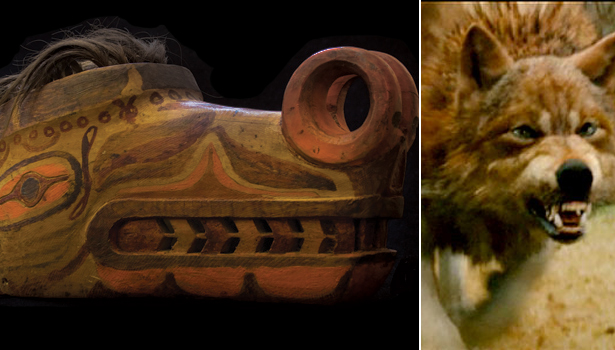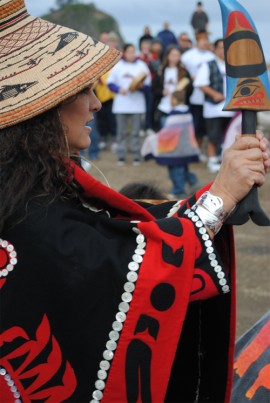
Quileutes do not turn into wolves.
Quileute culture has no references to vampires or Cold Ones.
Quileute men are not shirtless and prone to violent resolution of disputes.
Quileute women are not passive and subservient (three of five members of the Tribal Council, including the chair, are women).
And you can find a lot of Native and non-Native people who are financial equals.
For all of its popularity, the Twilight book and film series promotes several misconceptions about Quileute culture, Native people and women. The Burke Museum of Natural History and Culture, in collaboration with the Quileute Nation, has launched a website, Truth versus Twilight, to counteract those misconceptions.
The site explores the class and race stereotypes, antiquated and unequal representations of gender roles, and misappropriation and alteration of cultural symbols in Stephenie Meyer’s teen paranormal romance series. The site also explores the historic misrepresentation of Native peoples in advertising, film and media.
The website is one of several efforts born out of an idea session between friends after the first Twilight film was released in 2008; the group included Barbara Brotherton, curator of Native American Art at the Seattle Art Museum; Dr. Deana Dartt-Newton, Chumash, curator of Native American Ethnology at the Burke Museum; Jackie Jacobs, Lumbee, a public relations consultant; filmmaker Tracy Rector, Seminole, of Longhouse Media; and photographer Matika Wilbur, Swinomish.
One result was the year-long exhibit, Behind the Scenes: The Real Story of the Quileute Wolves, hosted by the Seattle Art Museum from Aug. 14, 2010 to Aug. 14, 2011. The Truth versus Twilight website launched Nov. 9 after two years of development.
The opening scene of Breaking Dawn, Part 1, the fourth film in the series, underscores the disparities. It opens with an aerial view of Quileute fictional character Jacob Black’s home: in need of repair, free weights holding down a tarp covering a leaky roof. Black emerges from the home shirtless and smoldering over Bella’s upcoming wedding to his nemesis, Edward Cullen. Next scene: the affluent vampire Cullen family in their upscale home. Bella will get married here and be whisked off (by sports car, plane and boat) to a honeymoon on a private island. Not bad for an 18-year-old.
Dartt-Newton said reaction to “Truth vs. Twilight” shows the importance of the site and other cultural education efforts. In the Quileute community, the site is viewed as a scholarly work. But among Twilight fans, it’s viewed as “making a mountain out of a molehill,” she said. “They say Twilight is just a fantasy.”
But in the Quileute rainforest community of La Push, home of the fictional Black family, some Twilight fans don’t always separate fact from fiction. Noted fiber artist Eileen Penn said Twilight fans have knocked on her door, asking if they can come inside and see her home. Others have knocked on neighbors’ doors, asking where Jacob, the fictional character portrayed in the film by actor Taylor Lautner, lives.
Chris Morganroth III, a Quileute carver and storyteller, was on the Tribal Council when the first film was released. He remembers receiving letters from Twilight fans saying they planned to visit La Push because they wanted to meet the characters in the film.
Morganroth, who was a consultant on “Truth vs. Twilight,” is disturbed by the misconceptions in the Twilight series. But he said the Twilight spotlight has given the Quileute people a broader audience to tell their story to. Dartt-Newton, who consulted with Morganroth in developing the “Truth vs. Twilight” site, agrees. “It’s enabled us to educate people we wouldn’t otherwise have access to.”
Morganroth was raised by his grandmother, who spoke only the Quileute language and imbued in his memory nearly 50 stories that are important to the Quileute culture. He said the best tellers of an indigenous people’s story are the people themselves.
“All Native peoples have tried hard to have our stories correctly told, so people understand we are who we are,” said Morganroth, who had a role in the 1992 Discovery Channel environmental film Oceans of Air.
The real Quileute creation story doesn’t resemble anything from Twilight. According to Morganroth, the Creator sent K’wati, the Transformer. K’wati changed wolves to the ancestors of the Quileute people at First Beach in present day La Push, and taught them how to live in their environment as people. Other spirit beings — Dask’iya (kelp-haired monster) and T’ist’ilal (Thunderbird) — shaped the Quillayute River and the local land forms into its present-day appearance. Thunderbird saved the Quileute people from starvation during the last Ice Age by bringing them a whale.
The Quileute people went on to flourish in a territory that extends from the isle-strewn Pacific Coast to rainforest rivers to the glaciers of Mount Olympus. “Today, Quileutes need only lift their eyes to see the burial place of chiefs atop James Island, or A-Ka-Lat,” the Quileute Nation website states. “This sense of cultural continuity is their birthright and heritage.”
Morganroth said exposure to the real Quileute culture gives a richer experience to all who are interested. Quileute leaders agree. Asked for comment, the council issued this statement: “During our travels as a collective, individually and with our youth, it has been our experience that most people are ‘in awe and thrilled’ to meet a ‘real Quileute.’”
Former Quileute chairman Russell Woodruff said the Twilight era has boosted tourism and given the local economy a shot in the arm. His daughter started Jacob’s Java, a coffee stand named for Jacob Black.
But Woodruff said the Quileute culture presented in the book and film “doesn’t fit our culture. It’s a different version altogether.” While he’s an advocate of strengthening the tourism sector of the local economy, he said he “wouldn’t go across the street” for the film.
The qualities of Quileute — its rich culture, forest, mountains, ocean coast, wildlife refuges and namesake river – stand on their own.
“A lot of people tell me this is prettier than the Oregon coast,” he said.
